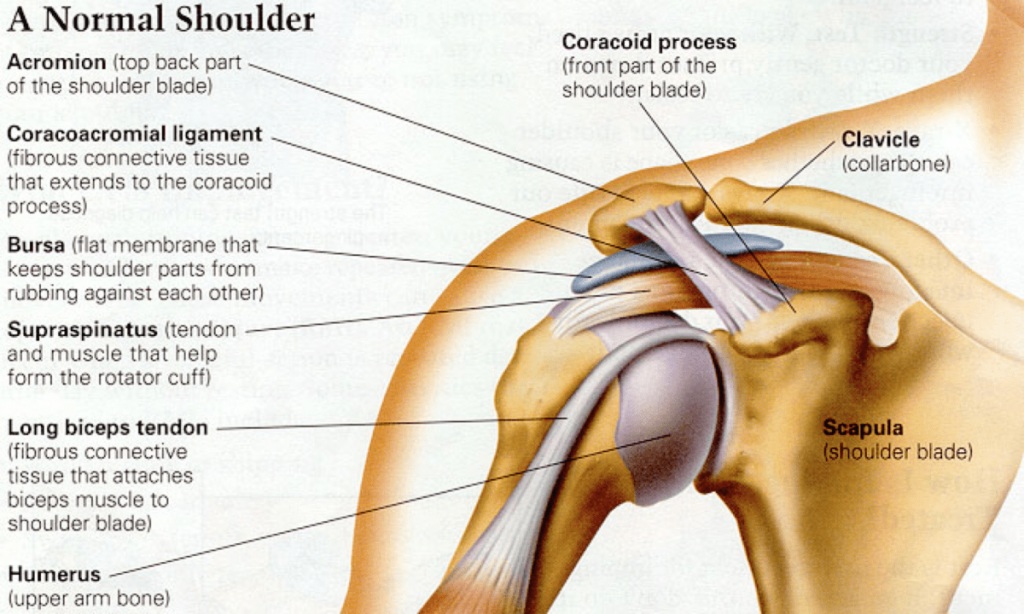Pain with reaching overhead or behind the back are two of the most common symptoms associated with bicep impingement & rotator cuff impingement. Thankfully, these diagnoses can be addressed with physical therapy. Many young athletes experience excruciating pain and discomfort when they move the bicep or rotator cuff. Yet, the problem can occur amongst middle-aged individuals that spend extended time in strenuous manual labor.
Symptoms
Made up of so many different joints, tendons, and muscles, your shoulder is vulnerable to a wide range of problems. More often than not, the bicep or rotator cuff is the source of shoulder pain. Bicep/ rotator cuff impingement can not only hinder your daily activities but also eventually result in inflammation. Early intervention ensures better and faster recovery from pain and stiffness.
Common symptoms of bicep impingement & rotator cuff impingement are pain in the front and lateral part of the shoulder when trying to reach above head or behind the back, pain with getting dressed, pain when lying on the affected side, and feeling weak throughout the shoulder and arm.
The injury may be graded in the following way based on its severity.
- Grade 1: Swelling and inflammation
- Grade 2: Weakened tendons in the shoulder
- Grade 3: Rotator cuff tears or shoulder bone changes
Other symptoms of bicep/ rotator cuff impingement include:
- Sudden pain in the shoulder
- The weakness of the muscles of the shoulder or arm
- Minor pain in the arm that won’t go away (even when you rest)
- Difficulty stretching your arm to the back
- Pain spreading from the front of the shoulder to the side of the arm
- Sleep disturbances due to increasing pain at night
Causes
The rotator cuff is comprised of four muscles that surround the shoulder blade with the main job of keeping the “ball” of the shoulder joint stabilized in the “socket” of the joint. The biceps are the more dominant muscles in the front of the arm that help to bend the elbow and raise the shoulder. Bicep/rotator cuff impingement is a diagnosis used to describe the result of narrowing of space between two bony structures that presses on the tendon of a rotator cuff muscle.

The most common causes of rotator cuff impingement and bicep impingement are:
- Age-associated problems in individuals aged between 40 and 60.
- Frequent movement or activities that cause excessive wear and tear of the rotator cuff. These include swinging a bat, swimming, construction work, etc. Often seen in young athletes, fitness enthusiasts or middle-aged labor workers.
- Traumatic pain caused by an accident or while lifting a heavy object.
- Individuals born with flat acromion are prone to deal with impingement caused by frequent friction.
If not treated immediately, the tendons may get further injured and actually tear in two, causing a rotator cuff tear. This weakens the muscles in the shoulder and arm, making it difficult for you to elevate your arm. For some people, the impingement process may rupture the biceps muscle.
In both cases, everyday activities, such as tying shoelaces, buttoning shirts, and lifting small objects become challenging.
Bicep/ Rotator Cuff Impingement Diagnosis and Treatment
You must consult with an expert and get proper treatment for bicep/ rotator cuff impingement. Your doctor may prescribe oral anti-inflammatory medications to relieve bicep/ rotator cuff pain, discomfort, and irritation.
In case your symptoms don’t go away, your doctor may consider giving you a shot of numbing medicine and steroids to reduce the swelling and soreness in your shoulder joint. Furthermore, an ultrasound or MRI may be necessary if your doctor suspects a rotator cuff tear. If the cuff is torn, you may have to undergo surgery.
Diagnosis
Your physical therapist will first take a history of your symptoms, including questions to understand your pain pattern, history of symptoms, how your symptoms affect your function throughout the day, and any help or doctors you may have seen. Next, your therapist will perform a thorough examination of your shoulder mobility, strength, muscle flexibility, and ability to perform functional activities (such as reaching overhead). Performing a comprehensive evaluation will help the therapist to understand the cause of the symptoms and how to treat it.
Treatment and Exercises
Your treatment plan will be personalized to you and your goals for therapy, whether it is getting back to tennis or being able to wash your hair without pain. The program will likely include hands on therapy and exercises focused on strengthening and flexibility that will help you get back to living the life you want.
We create therapy plans the cover everything from resting your shoulder joint, lifestyle changes to stretching. Targeted stretching exercises can strengthen your shoulder muscles. They reduce the stiffness and rigidity while improving your natural range of motion.
Request a consultation or give us a call @ 201-773-8851 to get started!

